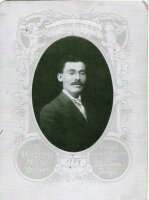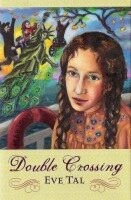 Double Crossing: Behind the Scenes
Double Crossing: Behind the Scenes
I think of Double Crossing as three stories:
Historical FictionThe story of Raizel
A book of Jewish folktales
Poem Writing Service
Double Crossing as Historical Fiction
My mother was not a storyteller, but she kept a large album with a plaid cover of family pictures. None of the pictures were in color. The earlier pictures were brown (sepia) and the later were black and white. Actually the earlier pictures were better than the later because professional photographers took them. No one had personal cameras in those days. To commemorate an important occasion, you went to a photographer dressed in your best clothes, stood in front of a fake background, and had your picture taken. I love these pictures. There is something so momentous about them. You can see that they were important to the people being photographed, and to the photographer. Compare these with the blurry, unbalanced pictures we call snapshots and you will see what I mean.
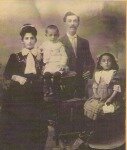
Benjamin, Eva (Haveleh), Rose (Raizel) and Lou (Lemmel) Altman. Probably taken soon after Eva's arrival with the children in America.
My mother would look at the album with me and identify the people in the pictures. That’s how she told me the story of her father Benjamin’s emigration to America. Like Papa in Double Crossing, he left to escape the Czar’s Army and to better the life of his family, but he did not take Raizel, my aunt Rose, with him. I was always fascinated by my grandfather’s story, and decided to write a children’s book about it.
Writing a novel based in a different period is not easy. I read many books about life in the shtetles of Eastern Europe, the difficulties of immigration, and the immigration process itself. My favorite sources were memoirs of people who lived during this time and wrote about their experiences, like Mary Antin. Memoirs provide a sense of the time: the smells, tastes, fears and joys of real people living their lives. I tried to convey this in Double Crossing.
I also visited Ellis Island several times. Ellis Island is a national monument. When you think of a national monument, you probably think of hiking trails and beautiful scenery. Ellis Island is different. It is an interactive experience in which you can see and hear what the immigration experience was like. They also have a wonderful library in which you can read and listen to the recorded memories of immigrants who passed through Ellis Island on their way to America.
The biggest problem I encountered writing historical fiction was the question of accuracy. How much research should I do? Could I ever do enough? At some point I made the choice to stop, but I can never be sure that the choice was right.
I can also never really be sure that all the details I used in the story are correct. Since it took me a long time to research and write the story, I cannot always remember where all my facts came from. That’s why several fact checkers read the manuscript before it was published to ask questions and provide criticism. Still, I expect that readers will find inaccuracies in Double Crossing. I just hope they don’t find too many...
[Back to Top]Shy Protagonists
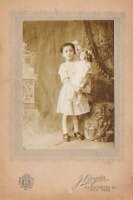
Rose (Raizel). Circumstances and date of the picture unknown.
When I was growing up, I didn’t care whether the protagonist of the book I was reading was a boy or a girl. I read everything I could get my hands on (yes, including comics). But even then I noticed that most of the protagonists were active, spunky, adventurous types. They weren’t all like Nancy Drew, but they always took the initiative. I loved and admired them, but truth be told, I wasn’t at all like them. I was shy, quiet, and timid. There weren’t girl protagonists like me in the books I read.
Sarah in All of a Kind Family by Sydney Taylor was an exception. Sarah loved books, wasn’t mischievous like her sister Henny, or a wonderful actress like her sister Ella. Sarah was shy, and I loved her for it. I wanted to write a book in which girls like me could identify with the main character. So I made Raizel shy. But like me, Raizel doesn’t let shyness and fear stop her from doing things. She hates leaving home (and to this day, so do I), is shy when she meets new people (so am I), but never lets her shyness get in the way of doing what she believes is right.
[Back to Top]Jewish Folktales
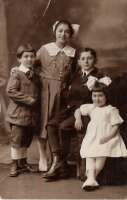
(L to R) Shalom (Shloyme), Rose (Raizel), Lou (Lemmel) and Hannah, my mother. Date Unknown.
One of my favorite books when I was growing up was a fat book called A Treasury of Jewish Folklore edited by Nathan Ausubel. It was the kind of book you could open to any place and always read something new. It was written for adults rather than children and I was never sure that I understood everything I was reading. This created a sense of mystery and wonder in me.
For some reason I never liked reading books of folktales for children. I loved the Andrew Lang fairy tale collections and read the Grimm brothers and Hans Christian Anderson, but I didn’t like the collections of Indian, African and other folktales that were rewritten for children. They always seemed didactic and simplistic. I never felt the same sense of mystery and wonder that the Ausubel collection gave me.
While working on Double Crossing, I completed a fascinating course in Folktales and Myth taught by Dr. J.D. Stahl in the Hollins University children’s literature program. I realized that I wanted to combine the Jewish folktales I had loved as a child with my novel. I had a “light bulb” moment: I would weave the tales into the story as naturally as possible, just as people once told stories. Without television, movies, or books to read, Raizel relied on folktales to provide her with the imaginative food her creativity required. It was as natural for Raizel to tell stories as it is for us to turn on the television or pick up a book.
At the same time, I worried that readers would find these stories boring. That they would slow down the story too much. That the reader would skip over the stories to find out what happens next. (I confess I used to do this when confronted with huge chunks of description, which were popular in the books I read as a child.) But I loved the stories too much to leave them out.
Do you think I was right to include them? Or did you dislike them and find them boring? I would love to know what you think.
To learn more about the folktales in Double Crossing, click here.
Picture of Benjamin Altman used for a New Year's Greeting Card in 1909. Probably sent to relatives in Europe the year before he brought his wife and children to America. (Amazingly, my cousin, Jeremy Altman M.D., looks exactly like our grandfather!) |
|
